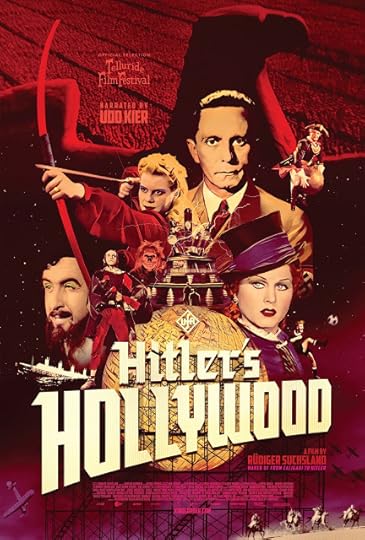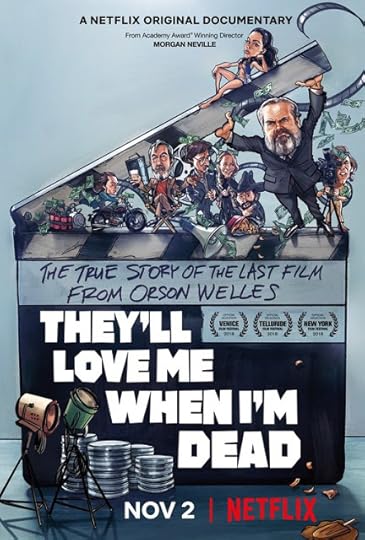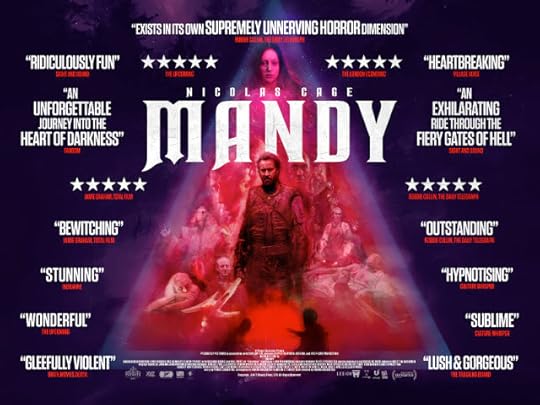Movies I Watched in November, Part 3
Wrapping up November with two fascinating documentaries and one even more fascinating fictional film...

People get the wrong idea about World War II-era Germany. That’s not to say it wasn’t a largely racist, mass murdering country led by a group of sociopaths – it definitely was – but that’s not ALL it was. Before it was largely bombed into rubble by Allied forces, Germany was a genuine world power, a cultural center, and most pertinent to this blog, a cinema hotspot. Since the early days of film, German directors had been leading the way. Legends like F.W. Murnau and Fritz Lang, along with dozens of others, fled to America when Hitler and his boys took power, but not everyone skipped town. Josef Goebbels, Hitler’s minister of propaganda, was a fiend for films, and if anything, the German movie industry expanded under Nazi rule. Which brings us, finally, to “Hitler’s Hollywood,” a fascinating documentary by Rudiger Suchsland that takes a detailed look at movies and movie stars I’m guessing you’ve never, ever heard of. Narrated by Udo Kier (a perfect, perfectly unnerving choice) and illustrated with hundreds of clips, “Hitler’s Hollywood” shows how German continued to turn out big-budget, popular movies in virtually every genre (except, oddly enough, horror and sci-fi, two genres pioneered by German directors in the silent era) and, subtly and not-so-subtly, wove strands of propaganda throughout just about every one of them. Sometimes it was less threatening stuff, the sort of thing Hollywood was including on a regular basis – strength of family, love of country, loyalty to government, that sort of thing. But this being Germany, circa World War II, the films also taught viewers to be subservient to the group, know their place in society and, most notoriously, don’t trust the Jews. Historical films were especially guilty of this, painting the Jewish people as the fault of the world’s ills and, by implication, deserving of whatever punishment they were receiving in the present day. There were other themes, too – one film has a kindly doctor who performs a mercy killing on his terminally ill wife. It may sound progressive for a 1941 film, but it was released just before the Nazis started using euthanasia to eliminate “undesirables.” This sensitive drama was actually propaganda to get the German public to accept the concept and tacitly approve its use.
One of the most intriguing things about “Hitler’s Hollywood” is the what-if questions it poses. If Germany hadn’t (a) started World War II and (b) become synonymous with monstrous evil, what might have happened to these actors and filmmakers? The clips do a great job of showcasing their star qualities and talent, and the scenes from dramas, comedies and musicals are very impressive – and not far from what Hollywood was creating at the same time. Clearly, they would’ve found a place in cinema history proper. Some of them, in fact, did. Detlef Sierck made Nazi movies for years before escaping to the west, where he became a legendary director under the name “Douglas Sirk.” And Ingrid Bergman, who was born in Sweden, made at least one movie for the Third Reich, just a few years before she came to America and fought for the goodguys in “Casablanca.” Hooray, I guess, for Hollywood.

If you watch Orson Welles’ famed “final movie,” “The Other Side of the Wind” on Netflix (and I definitely recommend that you do), be sure to watch the companion documentary, “They’ll Love Me When I’m Dead” as well. (It’s also on Netflix.) If nothing else, it will help put “Wind” into perspective, and you’ll get a better idea of (a) what you just watched and (b) how difficult it was for Welles to put together even the fractured version that sat on a shelf for decades. At best, “They’ll Love Me” is a portrait of a great director who had become largely a joke in Hollywood but never, ever gave up on making movies. Seeing him struggle to get something on film is frustrating, but it’s also oddly inspiring. And if you want to learn even more about “The Other Side of the Wind,” how it got made and how it – almost, but not quite – got lost forever, pick up a copy of Josh Karp’s “Orson Welles’ Last Movie: The Making of ‘The OtherSide of the Wind’.” It’s a fast-paced book that tells the whole story, except for the part where Netflix acquired the rights and actually released “Wind” – Karp’s book was written before that surprising turn of events took place. I enjoyed reading the book even more for that reason. At the end, Karp and everyone else is sad because they’ll never get to see the movie in question … and I had already seen it.

As soon as I saw the trailer for “Mandy,” I knew this was a movie I had to watch. Sure, Nicolas Cage starred in it, and I think Cage is legitimately great in a number of films, especially “Raising Arizona” and “Adaptation.” But Cage wasn’t the only thing compelling me to see “Mandy” -- it was everything in that trailer, from the guiding hand of director Panos Cosmatos (his 2010 film “Beyond the Black Rainbow” is a mind-bender) to the score by Johann Johannsson to the flashes of “Heavy Metal”-esque animation to the biker gang that looked like something from “Hellraiser” to the way co-stars Andrea Riseborough and Linus Roache seemed to blend into each other at a certain point. Also, Nicolas cage using a chainsaw to fight a guy with an even bigger chainsaw. Also, Bill Duke. Also, a tiger. How could I not want to watch that? Just seeing if Cosmatos could fit it all into a semi-coherent film would be worth the price of admission.
And, I’m happy to say, I wasn’t disappointed, even though "Mandy" pushed the boundaries of "semi-coherent" about as far as they could go. Sticking this one into the blu-ray player Thanksgiving night, when the wife and child were away (and trust me, this is not something they would have enjoyed), I immersed myself in the strange, disturbing, exciting, balls-out crazy world of “Mandy.” I’ve heard tell of movies that are best experienced when you’re high (never done it myself personally – I’m too much of a movie nerd) and this film certainly seems to fall into that category, but even more than that, “Mandy” seems to deliver a bit of a contact high all by itself, with its unique combination of sound, visuals, performances and (something reviewers seem to be ignoring) pacing creating an enveloping, oddball reality of its own.
The movie is very much divided into two halves, the second delivering all the craziness (both from Mr. Cage and otherwise) that you'd expect from the trailers, but the first being a surprisingly methodical and emotional prelude to the mayhem, setting up the relationship between our loving couple -- woodsman Red (Cage) and paperback fantasy fan Mandy (Riseborough). We get to know them, in a way, and get a feeling for how much they love each other. It's touching, but it's also troubling, because we know how horribly wrong things are about to go. And then, when they do go wrong (and boy oh boy, do they ever), you realize that the slow, deliberate first half was Comatos winding up the springs so he could release them in the second half. Everyone is raving about Cage's unleashed performance in "Mandy," and he deserves the accolades, but let's be honest: Cage has delivered some pretty unhinged acting in some fairly terrible movies. Here, though, it all serves a purpose. Rather than watch an actor cut loose, you're watching a character react, and it's a thrilling, mesmerizing, even draining experience. But it's never boring, and Cage is never less than riveting. What's more, "Mandy" manages to convey they feeling of a nightmare you can't wake up from (and I mean that as a compliment), with elements not making logical sense but somehow making perfect emotional sense. Saying "Hell, that could never happen!" or asking "Why did the hell that happen?" is missing the point. This is one movie where you need to go along for the ride.
Published on December 22, 2018 14:30
No comments have been added yet.
Will Pfeifer's Blog
- Will Pfeifer's profile
- 23 followers
Will Pfeifer isn't a Goodreads Author
(yet),
but they
do have a blog,
so here are some recent posts imported from
their feed.



